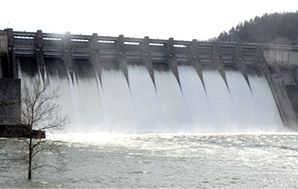Constant rain, high level, heavy release


Heavy rains have resulted in unusually high levels for this time of year at both Lake Cumberland and Dale Hollow Lake.
This past weekend, the overlook above Wolf Creek Dam, as well as the park below the dam adjacent to the Cumberland River were extremely popular places for people looking at and photographing not only the high water levels against the dam, but also the use of all 10 flood gates releasing water into the river.
On Monday afternoon, those gathered at the dam overlook were sent scrambling when a large rock slide from the adjacent bluff came crashing down onto the roadway.
The resulting pile of rock pushed concrete barriers across U.S. 127, making the roadway impassable and leaving the road closed for several hours Monday while crews worked to remove the rocks.
No injuries were reported due to the rock slide.
While the release of water had the ground shaking at a rate of just over 28,000 cubic feet per second, the U.S. Army Corps of Engineers are planning to “open the faucet” even more when possible.
All of this comes with the prediction that before the end of this week, the region, including Albany and Clinton County, could receive as much as six to eight additional inches of rainfall.
The U.S. Army Corps of Engineers Nashville District plans to increase releases at Wolf Creek Dam in Jamestown, Kentucky, as soon as conditions allow in an effort to drawdown the water level at Lake Cumberland.
Water managers at the Nashville District headquarters in Nashville, Tennessee, said Wolf Creek Dam is currently discharging water at a rate of 28,000 cubic feet per second, but plan to increase to 35,000 cfs as soon as conditions allow.
In preparation for the increase, Corps of Engineers officials are working with local officials to install a “Hesco” temporary flood wall on River View Road just downstream of the dam where water backs up from the Cumberland River into Little Indian Creek and inundates this remote country road. When the water releases reach about 30,000 cfs the roadway becomes unpassable, blocking public access to about 20 parcels of land and about 30 structures.
Jerry Breznican, Nashville District Emergency Management Chief, said the Corps of Engineers is working with local authorities to make every effort to keep the roadway open for landowners as the Corps increases releases at the dam.
“We’ve coordinated with the Louisville District Emergency Management Section on the delivery of the temporary flood wall,” Breznican said. “Wolf Creek Dam personnel are standing by tomorrow to assist with unloading equipment and partnering with Russell County officials who have committed to support with its construction.”
The Nashville District plans to have the temporary flood wall in place before increasing releases at Wolf Creek Dam in order to keep the roadway accessible.
“It takes about 48 hours to construct the temporary flood wall,” Breznican said. “We are monitoring the situation and are supporting the operation throughout the weekend.”
The current elevation at Lake Cumberland is the highest observed since April 25, 1998 when the pool crested at 742.44 feet. The pool of record is 751.69 set in May 1984.
In 2019 inflows are averaging 33,270 cfs and the lake has risen 19 feet. Although the current elevation of the lake is 736.7 feet, only 34.4 percent of the flood control pool is currently being utilized.
Anthony Rodino, Nashville District Water Management Section chief, explained that the Nashville District is releasing as much water as downstream conditions allow in an effort to regain storage in the reservoir. He noted that the period of record median elevation observed for February 15 is 703.7 feet and the typical operation of Wolf Creek Dam allows the lake to fill from elevation 700 to 723 feet by mid-May.
“If we receive no additional rainfall in the watershed, we will not reach typical seasonal elevations until the middle of March. If we receive historical average rainfall, we will not reach seasonal elevations until mid-April,” Rodino said. “This means that we expect to maintain higher than average discharges from Wolf Creek Dam for the foreseeable future in order to keep up with unseasonably high inflows.”
The flood control pool at Lake Cumberland spans elevations 723 to 760, which allocates 2,094,000 acre feet of storage in the pool and allows for storage of 6.78 inches of rainfall runoff in the 5,789 square-mile watershed.
Wolf Creek Dam provides flood control benefits for communities downstream. The water management plan designates Celina, Tennessee, as the downstream control point. The flow at Celina, which is made up of discharges from Wolf Creek Dam and Dale Hollow Dam as well as the 583 square miles of uncontrolled watershed below the dams, is maintained at or below 40,000 cfs.
The dam is a critical component to the Corps’ ability to mitigate flooding in the Cumberland River Basin. With the possibility of significant rainfall next week and the availability of 65 percent of the flood control pool in the reservoir, the Corps could revisit the decision to increase discharges from the dam and the discharge plan could change. However, as downstream conditions allow, it remains a priority to release as much water as possible from Wolf Creek.
Wolf Creek Dam last discharged water at a rate of 35,000 cfs in March and April of 1997. The flow of record from Wolf Creek Dam is 40,000 cfs in January 1974. River View Road had not been developed at that time.




